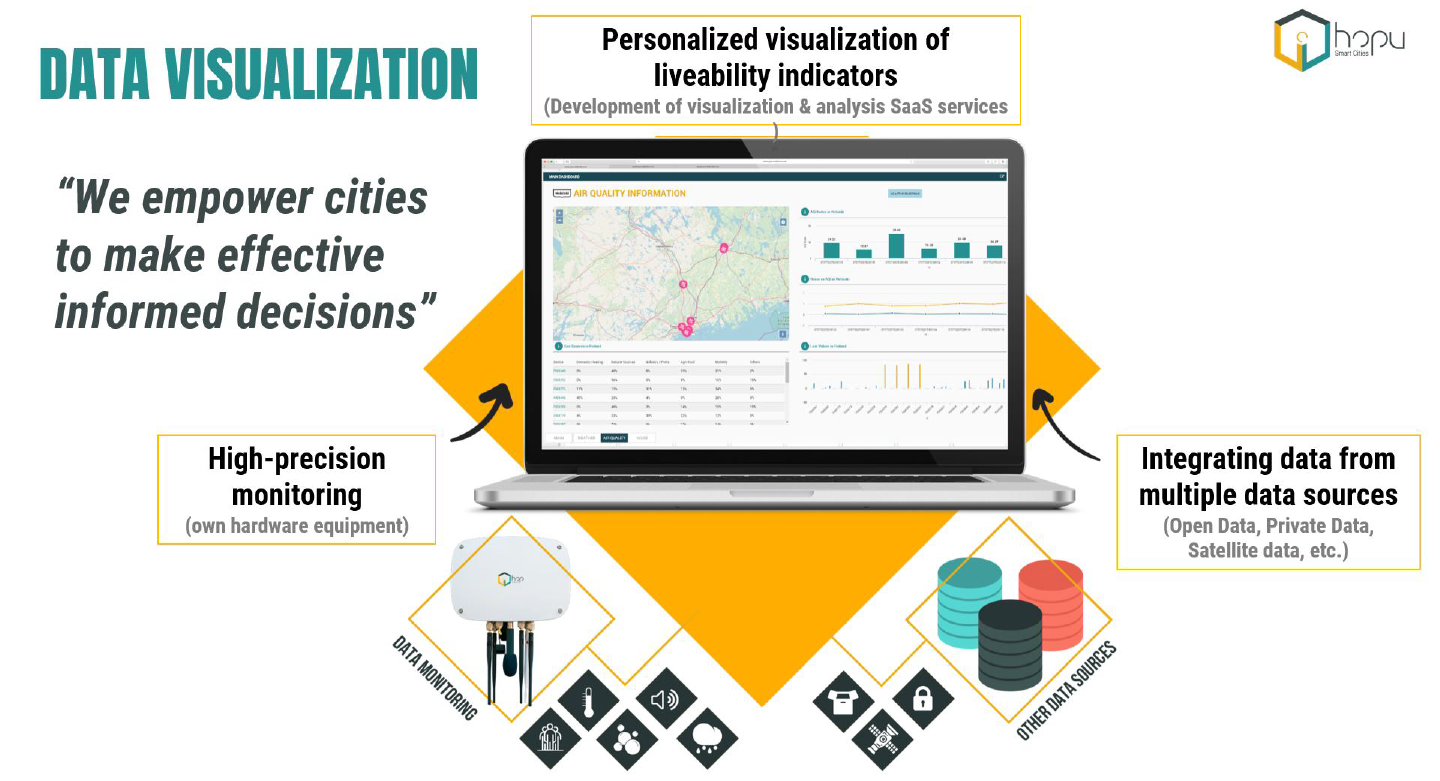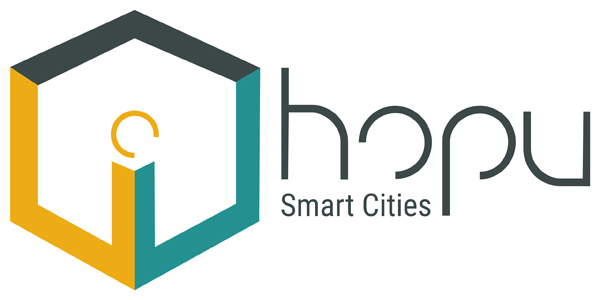Challenge & Context
Until recently, the Authority for the Island of La Palma (Canary Islands, Spain) was seriously concerned about the quality of the air the inhabitants of the island were breathing, mainly due to two factors: the growing economic activity in a predominantly rural island (with tourism as a main driver) and the volcanic activity of an island home to more than 10 active volcanoes (in a territory of just 708 square kilometres).
This concern was framed within the initiative La Palma Smart Island, which aimed to use digital solutions in order to improve the delivery of services for the citizens on a wide range of topics, including liveability conditions and the environment. This involved the installation of weather stations and air quality sensors (gases and particulate matter) throughout the whole island.
Some of the difficulties posed by this challenge were the complicated orography of the terrain, the geographical remoteness of the Canary Islands (only accessible by sea and air), and, of course, the ever-present volcanic risk in the archipelago.
Though remote, this risk materialised in the summer of 2021, with the eruption of the volcano La Cumbre Vieja. This posed two main challenges: the risk of destruction of the devices due to the lava flows, and the delivery of data in real-time under these hard conditions. Furthermore, the concern regarding the quality of the air the citizens of the island were breathing skyrocketed, as the health of thousands of people was at stake.
The Island of La Palma and HOPU were facing two challenges that needed immediate action: providing reliable information under uncertain conditions and making this information as accessible as possible to a growing amount of people interested in it.
Solution
The deployment of the devices on the island of La Palma was an unusual project for HOPU, a company more focused on Smart Cities. However, the project was successfully executed with the support of local authorities and the IT partner, Telefónica.
The main milestones in the project were the following:
- Deployment: within the initiative La Palma Smart Island, HOPU managed to deploy and integrate into FIWARE a whole network of more than twenty air quality sensors, providing a real-time insight into the pollution on the island and an Open Source of visualisation of the atmospheric conditions.
- Connectivity: thanks to a powerful partner such as Telefónica, the communication network managed to cover the whole island, providing a complete perspective of the area. This comprehensive coverage of the island was even more relevant when the volcanic eruption took place, in order to identify the affected areas and how the pollutants released by the volcano were evolving.
- Monitoring: the devices deployed aimed to measure the conditions in real-time, helping to assess the liveability of the island and, therefore, preventing thousands of citizens from being exposed to harmful gases.
- Display of information: the Open-Standard solution allowed every interested citizen or information provider to easily access data and information regarding air quality, providing easy dissemination of information when it was needed – to an extent, it democratised this relevant information, since it was accessible to any media or information provider interested in displaying it.
The high accuracy and wide range of measuring of the devices, together with a strong network of communication, allowed them to keep delivering the service once the volcano erupted and the sensors were exposed to unusually high levels of gas and heat.
How it works
The solution created for monitoring the air quality in this context relies both on precise devices in accurate locations and a simple, accessible way to present the information.
On the one hand, information regarding the air quality is obtained by electrochemical and optical sensors and stored in a central device that is wirelessly connected through GPRS, WiFi, and 3G/4G, providing information to either the company’s or the client’s servers. This information is later displayed in a SaaS-Visualizer (Grafana) based on FIWARE Open Standards.
In this case, information regarding ozone, carbon monoxide, and sulphur dioxide, as well as particulate matter, was collected (the typical portfolio of HOPU also includes carbon monoxide and dioxide, and nitrogen oxides).
Figure 1 . Indicators Services/p>
On the other hand, FIWARE provides the basis to store and display the information collected by the sensors, enabling access to real-time data without the need for any registration, log-in data, or apps. It also serves as a host for the SaaS-Visualizer tool and the information generated by it (not only environmental parameters but also the time series, graphs, GPS location, and the warning when a certain level of pollution is reached).
In this sense, the use of FIWARE technology proved its utility to spread the information to different audiences, informing the inhabitants of the island of La Palma about something as basic, but still innovative, as their living conditions under an uncertain environment. It also provided support to integrate a large number of sensors into its platform, allowing a wide coverage of the situation on the island.
This case showed how the air we breathe impacts our health, how important it is to obtain reliable information regarding our own environment, and how easy the access can be for the general citizen.
Benefits & Impact
Though this story focuses on the island of La Palma, more cities, regions, and governments are concerned about the air they breathe, either due to natural factors or, more commonly, due to human activities. The EU Green Deal and the decarbonization tendency across the continent pose an important opportunity in the information on air quality to improve the liveability in cities.
In this sense, the solution proposed by HOPU unifies steps and systems from the data collection phase to the conclusion development for decision-making in a single and usable tool. Due to this global tool, cities can reduce the time dedicated to making informed decisions and automatically ensure that the decisions are more effective.
HOPU has experience in monitoring the air quality in more than 50 municipalities and regions, including Madrid, Barcelona, Palma de Mallorca, Bordeaux, Thessaloniki, Helsinki and Paris, and this number is expected to increase in the years to come. Some of these successes are listed in the FIWARE Marketplace.
According to data provided by the European Commission, there are more than 800 cities with more than 50,000 inhabitants, only in the EU. These cities are increasingly concerned about their liveability, and the trend is expanding to other areas of the world such as North and South America or Asia.
In this aspect, HOPU has developed new applications of environmental data, such as its new solution for Low Emission Zones (LEZ), which integrates air quality and mobility data to present the effect of different mobility-related policies, providing a strong tool for city administrators in this aspect.
To sum up, the aim of HOPU is not only to grow as a company but to improve the life of citizens and the efficiency of governments through smart solutions aiming at the reduction of CO2 and other polluting gases.
Added value through FIWARE
The FIWARE Smart City platform components help in the software development of HOPU tools through enablers such as the Orion Context Broker and IoT agents. This technological structure – which follows a common European standard – has brought a very relevant angle for the public administration market towards being more integrable, open, and standard.
FIWARE as a community is a relevant ecosystem to grow as an SME, due to the marketing and communication activities promoted by them and through the opportunities in the European market sector that the foundation provides. HOPU has participated in more than 10 international events in the last years, collaborating with FIWARE, and augmenting their impact in them with their marketing and communication support. FIWARE has promoted HOPU as a FIWARE-ready Device in their different networks, contributing actively to expanding their market.
HOPU is an active part of FIWARE Foundation contributing to dissemination tasks as FIWARE Evangelists, and working actively in the technological growth of the different enablers.
HOPU has been an active partner of FIWARE Foundation and its ecosystem since its beginning, based on shared values.
HOPU’s services and products have been supported by relevant networks in the area of sustainability such as CLIMATE KIC and through major European projects such as Synchronicity. Additionally, HOPU is are a Gold Member of FIWARE Foundation, part of OMA (real-time communication protocols OMA LwM2M, OMA NGSI), and Chair of IEEE in the IoT sector for Data Quality (IEEE P2510).
Next Steps
Following the fusion between HOPU and Libelium in mid 2022, the aim of the combined company is to become the leader in the Spanish Market for IoT, and to set the basis for a solid expansion to other markets (in the EU, as well as in the rest of the world).
In this sense, some of the steps to take include:
- Offer more complete solutions combining air and water quality, parking, agriculture, and mobility.
- Define a strong network of partners, especially in Europe and South America.
- Be in more than 200 cities in a short term.


